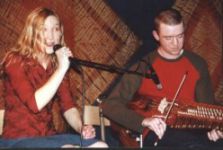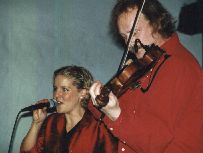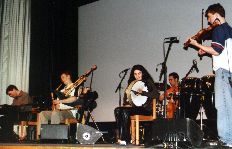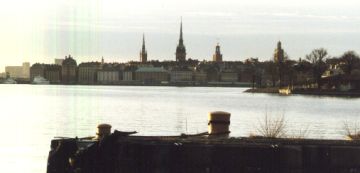 Written
in May 2001.
Written
in May 2001.  Written
in May 2001.
Written
in May 2001.
Stockholm has changed completely during the last months - during May it transformed from an attractive winter city to a green city with people sitting outside everywhere. Along to the weather, also the people have melted, now obviously being happier and also more approachable. Along with the start of the summer, the Stallet (translated: The barn), Stockholm's best folk music venue, closed their first ever season successfully.
The Stallet was started in November 2000 by the RFoD, the national society for folk music and dance. Before that, there was a political debate in the Swedish parliament about culture - and among that in particular folk music - and cultural funding. The government decided in their budget plan to support the RFoD in putting up a venue for folk music and dance as a centrepiece of the Swedish folk scene, promising 400.000 Kroner (ca. 50.000 Euro) funds a year. Stallet is run now in co-operation with Rikskonserter (a public organisation for concerts) and with financial support from the Cultural Council, the city and the region of Stockholm. Parallely, it was also decided to establish two new folk music institutes, the Eric Sahlströms Institutet in Tobo and the Folkmusikens Hus in Rättvik.
 RFoD offered a proposal for the role of themselves and the folk music scene.
To find out how these proposals were perceived by the politics, they asked all
political parties to contribute their opinions about the role of folk music
and dance. And - interesting enough - most parties came back with a very differentiated
opinion about folk music, and nearly all welcomed an additional support for
the folk music scene, stressing the importance of the folk music scene for Sweden.
I am rather impressed by this awareness of politics for folk music in Sweden
- I could not imagine that alone one of the German parties could say anything
professional about folk music.
RFoD offered a proposal for the role of themselves and the folk music scene.
To find out how these proposals were perceived by the politics, they asked all
political parties to contribute their opinions about the role of folk music
and dance. And - interesting enough - most parties came back with a very differentiated
opinion about folk music, and nearly all welcomed an additional support for
the folk music scene, stressing the importance of the folk music scene for Sweden.
I am rather impressed by this awareness of politics for folk music in Sweden
- I could not imagine that alone one of the German parties could say anything
professional about folk music.
Still, after having been 5 months in Stockholm, I can not say that folk music is very main stream here; it is - as in so many countries - a small circle of enthusiasts; and most of the times, there are not many "guest" visitors in the audience. Even those names that are supposed to be well-known (like Hoven Droven or Garmarna) would attract normally not a huge crowd. At the same time, the society is still very much linked to their traditional music - if you tell young people that you like folk music, it is quite likely that they will answer that their granddad, dad or anybody else in the family is a "Spelman" (mostly a fiddler), and that they like it (although most of them would not listen to folk music outside of the family context).
 The programme of Stallet has been really impressive in April and May, with
a lot of highlights, and all in all more than 30 events in two months! Difficult
to be at all events; so I just picked out some highlights. Still in March, Ulrika
Bodén, the singer of Ranarim, presented with some musical friends her
new solo CD (where the friends are also joining her). She had collected for
this CD and concert songs and tunes from the region of Angermanland, and could
well impress the audience with her beautiful voice, and the informative, sometimes
witty introductions to them.
The programme of Stallet has been really impressive in April and May, with
a lot of highlights, and all in all more than 30 events in two months! Difficult
to be at all events; so I just picked out some highlights. Still in March, Ulrika
Bodén, the singer of Ranarim, presented with some musical friends her
new solo CD (where the friends are also joining her). She had collected for
this CD and concert songs and tunes from the region of Angermanland, and could
well impress the audience with her beautiful voice, and the informative, sometimes
witty introductions to them.
One of Ulrika's friends, also playing in Ranarim, was back on stage just a couple of weeks later, then with his band "Nyckelharpsorkestern". At that concert, there was a support act - a nyckelharp orchestra actually, so it was an evening filled with Nyckelharpas, proving that the interest for nyckelharpa is quite big right now. In "the" Nyckelharsporchestern, five of the best Nyckelharpa players of Sweden come together: Niklas Roswall (Ranarim), Olov Johansson (Väsen), Ola Hertzberg, Markus Svensson and Henrik Eriksson. Although the band features just that one instrument, there is a lot of innovation and excitement in the music of the lads. Probably not everybody's cup of tea though.
One of the highlights was probably the Easter concert of Sweden's wonderful
folk rockers Hoven Droven at the Stallet (see live review!);
a delicious Easter egg. There was another of Sweden's best folk bands in April
at the Stallet: Groupa. Last time when I saw the band, their singer Sofia Karlsson
was not able to join the concert due to bad health; this time she was around,
but flautist Jonas Simonsson could not play. For a band like Groupa, this is
not a major problem, they can also very well perform with one of the band members
missing. Groupa's music is exciting, bridging folk music with jazz and world.
Their Norwegian percussionist has the craziest selection of "eco"
percussion you are likely to find. Singer Sofia Karlsson adds an attractive
new dimension into Groupa's music, with a style that swings between traditional
and jazzy. A very good concert.
 Something a bit different from all the polskas on fiddle and Nyckelharpa that
you usually here at the Stallet, was Gunnfjauns Kapell's concert. This band
comes not from the Swedish mainland, but from Gotland, an island with its very
own distinctive history, culture and dialect. Their music is highly attractive,
featuring guitar, flute, accordeon, fiddle and vocals. Being around already
since 1982, Gunnfjauns Kapell has only since recently their singer Charlotte
Berg, with an attractive voice and a positive (at times maybe too positive)
performance. The music of the Kapell is based in the traditions of Gotland,
yet they add their own touch to it. Out comes beautiful high quality music,
very harmonic and peaceful. I loved it.
Something a bit different from all the polskas on fiddle and Nyckelharpa that
you usually here at the Stallet, was Gunnfjauns Kapell's concert. This band
comes not from the Swedish mainland, but from Gotland, an island with its very
own distinctive history, culture and dialect. Their music is highly attractive,
featuring guitar, flute, accordeon, fiddle and vocals. Being around already
since 1982, Gunnfjauns Kapell has only since recently their singer Charlotte
Berg, with an attractive voice and a positive (at times maybe too positive)
performance. The music of the Kapell is based in the traditions of Gotland,
yet they add their own touch to it. Out comes beautiful high quality music,
very harmonic and peaceful. I loved it.
This was just a very little extract of Stallet's programme. At the end of May, Stallet went into its first summer break. All in all it seems that it was a highly successful first year. Probably the most distinctive thing about the Stallet is that always in the second half of each concert the chairs are taken away to leave room for dancers. It is a nice idea, although at times I wished to be able to see full concerts of bands, giving the musicians the attention they deserve also during the second half. But of course this is a question of taste. Dancing is very central in the concept of RFoD, and also in the folk music scene in Stockholm, and as long as the audience likes it, it's absolutely fine.
 RFoD has of course a lot of other activities besides organising the Stallet
and lobbying for the folk music scene. One example is that they organise in
cooperation with the Rikskonserter folk music tours, both inside of Sweden and
internationally. Ranarim toured recently with RFoD's support the States. Menawhile,
RFoD invited in March Slainte Mhàt from Nova Scotia, Canada for a Sweden
tour. This tour went to a big extent to schools, offering the pupils the possibility
to discover folk music.Touring mainly through little towns and villages, and
playing besides schools also in little village halls, this tour was a great
success. Slainté Mhát are surely a good band to do a school tour,
as the band is still young enough, and as a lot of the school girls would love
to go backstage to meet the sweet boys afterwards (at least it was like that
at the school concert in Gnesta).
RFoD has of course a lot of other activities besides organising the Stallet
and lobbying for the folk music scene. One example is that they organise in
cooperation with the Rikskonserter folk music tours, both inside of Sweden and
internationally. Ranarim toured recently with RFoD's support the States. Menawhile,
RFoD invited in March Slainte Mhàt from Nova Scotia, Canada for a Sweden
tour. This tour went to a big extent to schools, offering the pupils the possibility
to discover folk music.Touring mainly through little towns and villages, and
playing besides schools also in little village halls, this tour was a great
success. Slainté Mhát are surely a good band to do a school tour,
as the band is still young enough, and as a lot of the school girls would love
to go backstage to meet the sweet boys afterwards (at least it was like that
at the school concert in Gnesta).
I will miss the Stallet when having left Stockholm in autumn. It is a friendly venue, and the quality of the music is amazing, offering in just half a year a big percentage of the important names of the Swedish scene. Good luck for the future to RFoD and the Stallet!
Next issue there will be a final article on the Swedish scene, along with a report from the Falun Folk Festival.
Further Reading and Info on the Swedish Folk Music Scene:
The first three parts of the Scanfolk series:
Photo Credit: Photos by the Mollis
(1)Stockholm from the air, the Stallet is located on the far right on the waterside (2) Ulrika Bodén & Niklas Roswall, (3) Groupa (4) Slàinte Mhat (5) Stockholm
Back to the content of FolkWorld
Articles, Live Reviews & Columns
To the content of FolkWorld
online magazine Nr. 19
All material published in FolkWorld is © The Author via FolkWorld. Storage for private use is allowed and welcome. Reviews and extracts of up to 200 words may be freely quoted and reproduced, if source and author are acknowledged. For any other reproduction please ask the Editors for permission.
